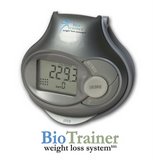
The International Bottled Water Association has a great online calculator to determine your water needs and provide the following tips.
Keep in mind that there are other factors that may require you to drink more water. Here's a look at a few:
Dry Air Up There: To combat low humidity levels on airplanes, drink one 8-ounce serving of water for every hour in the air.
Winter Woes: The colder it gets outside, the more energy your body requires to maintain a 98.6 degree temperature, AND the more water your body needs. So be sure to drink extra water in cold weather.
Flu Blues: Maladies such as pneumonia and the flu can sometimes lead to dehydration, so be sure to drink more water when you are sick.
Beat the Heat: If you plan to spend considerable time outside in warm weather, prepare by drinking one to two extra 8-ounce servings of water.
Moms Need More: Due to high concentrations of water in breast milk, nursing mothers require three additional 8-ounce servings of water per day. Drink up, mom!
Pregnancy Increases Need: You'll gain as much water weight as baby weight when you are pregnant. This is in the form of increased blood volume, amniotic fluid, and tissue fluids. Be sure to drink 8 to 12, 8-ounce servings a day.
Tuesday, March 27, 2007
How much water do you need?
Sunday, March 25, 2007
How the BioTrainer works
The BioTrainer quantifies motion; it records your movements and gives measurements in one of two ways:
• Activity Units - This is a method measuring your overall physical activity based on your body movements. Activity units CAN’T be affected by other factors such as age or weight. With activity units, The BioTrainer can be worn on different body parts depending on the activity or type of exercise.
• Calories - It can accurately calculate the calories burned as a result of exercise. You actually burn calories in two ways:
One is physical activity calories (which the BioTrainer measures), that are burned as a result of engaging in physical activity, such as exercise.
The other way is metabolic calories, which result from the body’s natural metabolic rate, even when you are inactive. Some of these would include breathing, digesting food, sitting, sleeping, and other “non-exercise” activities.
Wednesday, March 21, 2007
Almonds found to help regulate appetite, caloric intake
Daily consumption of almonds may trigger feelings of satiety and help reduce overall calorie intake, according to research by scientists from Purdue University.
Dieters often find it difficult to regulate their appetite, but a new study recently presented at the North American Association for the Study of Obesity's annual meeting indicates that almonds may help stop unhealthy snacking by enhancing feelings of fullness between meals.
The study -- funded by the Almond Board of California -- examined the effects of supplementing the diet with almonds on 20 overweight women. The participants were divided into two groups: The first was given two servings (300 calories) of almonds a day for ten weeks, followed by 10 weeks with no almonds, while the second began with 10 weeks of no almonds, followed by 10 weeks of two daily servings of almonds.
The researchers, led by Richard Mattes, found that when the women were supplementing their diets with almonds, they experienced no changes in energy intake, body weight, body fat or body mass index (BMI).
"We concluded that the women found their daily almond snack to be very filling, and so they naturally compensated in the caloric intake at other times of the day," Mattes said.
Essentially, because the almonds triggered feelings of fullness, the women consumed fewer calories from unhealthy sources.
They also noted that some of the fat found in almonds is not digested or absorbed by the body after consumption, which leads to lower caloric intake than the number indicated on almonds' nutrition labels.
The researchers stressed the need for larger, longer trials to prove their findings, as well as additional studies to determine which almond compounds are responsible for satiety.
Consumer demand for almonds has dramatically increased in recent years as the nuts' health benefits have become more widely known.
Tuesday, March 13, 2007
Walking burns more fat than running
 According to the University of Iowa's Family Care Center's Counseling and Health Promotion Services, starting a walking program can produce remarkable results. By beginning at a slow pace and gradually building to a vigorous walk at least 30 minutes four or five times a week can improve muscle tone, ease stress, boost your energy level, and burn between 180 to 250 calories in each session.
According to the University of Iowa's Family Care Center's Counseling and Health Promotion Services, starting a walking program can produce remarkable results. By beginning at a slow pace and gradually building to a vigorous walk at least 30 minutes four or five times a week can improve muscle tone, ease stress, boost your energy level, and burn between 180 to 250 calories in each session.
Posted by BioTrainerUSA at 3/13/2007 08:59:00 AM EMAIL THIS POST
Labels: Fitness Research
Thursday, March 8, 2007
Successful dieters buddy-up for results
Veteran workout buddies share their tips for pairing up. from the Lansing State Journal
- Get a buddy. You might be more successful at losing weight, keeping it off and exercising regularly when meeting with a group or partner.
- Eat fewer calories. You lose weight when you consume fewer calories than you burn through regular activity and exercise.
- Exercise regularly. More than 90 percent of the people in the National Weight Control Registry who have kept their weight off use physical activity as part of their weight-control program.
- Weigh yourself daily. Plan for how to get back on track if your weight begins to creep up.
- Eat a healthy breakfast. You'll be less likely to snack all day or binge at lunch and dinner. Try low-fat yogurt sprinkled with low-fat granola, low-sugar cereal with low-fat, skim or soy milk, or fruit smoothies.
- Watch the fast food. People in the registry eat fast food less than once a week and eat out no more than three times a week.
- Don't be a couch potato. Most people successful at keeping off the weight watch less than 10 hours of TV a week, far less than the 28-hour average. If you do watch TV, try to exercise instead of eating while you watch.
- Stay consistent. Going off your diet on special occasions, weekends or holidays makes it tougher to truly change your lifestyle and keep weight off.
Monday, March 5, 2007
Some Retro Footwear from the 80's
An iconic "must-have" of the 1980's pop culture scene, the Reebok Freestyle will forever go down in history as the athletic shoe that changed the face of women's fitness. Twenty-five years later, the Reebok Freestyle remains one of the best selling shoes of all time.
Reebok is celebrating its 25th anniversary with a special collection of six limited-edition shoes. Called “Freestyle Forever”, the 2007 Freestyle collection will also feature six limited-edition Freestyles varying from authentic bring backs to modern-day artist collaborations. Beginning this month the footwear will be available on www.rbk.com and at select boutiques around the world for a suggested price range of $65-$150.
"Reebok is passionate about debuting the 25th Anniversary Freestyle Collection because the shoe represents our history as the brand that pioneered the women's fitness movement and started the high-top fashion trend," said Reebok's Chief Marketing Officer, Uli Becker. "Today, fashion is about freedom of expression and keeping it real. Back in the '80s, the Freestyle was worn by women who wanted to make a statement about their authenticity and individuality, and that still holds true today."
One of the first athletic shoes created especially for women, the original Reebok Freestyle symbolized female empowerment. After revolutionizing the industry and igniting the women's aerobics dance craze in 1982, the Freestyle made up more than half of the sales for Reebok in 1984. In 1986, Reebok launched the ad campaign "Life Is Not a Spectator Sport." Highlighting
the Freestyle, the campaign encouraged women to become active participants in the world of fitness. This message strongly resonated and gained an astounding following of trendy young female consumers of the time. The groundbreaking ad coupled with top celebrity endorsements, including model Cindy Crawford, singer Paula Abdul and most notably the appearance of iconic actress Cybill Shepherd wearing a bright orange pair at the 1985 Emmy Awards, solidified the
Freestyle's status as a key fashion item.
Thursday, March 1, 2007
Desk Exercises
You're at your desk before dawn and won't be leaving until after sundown - but a sedentary day is NOT going to be good for your back, your shoulders, your waistline or your spirits... what to do? Enjoy this wonderful page of desk exercises you can squeeze in anytime - some even while you're on the phone with your boss! Desk Exercises


 BioTrainer visits Dr. Fitness and The Fat Guy
BioTrainer visits Dr. Fitness and The Fat Guy




